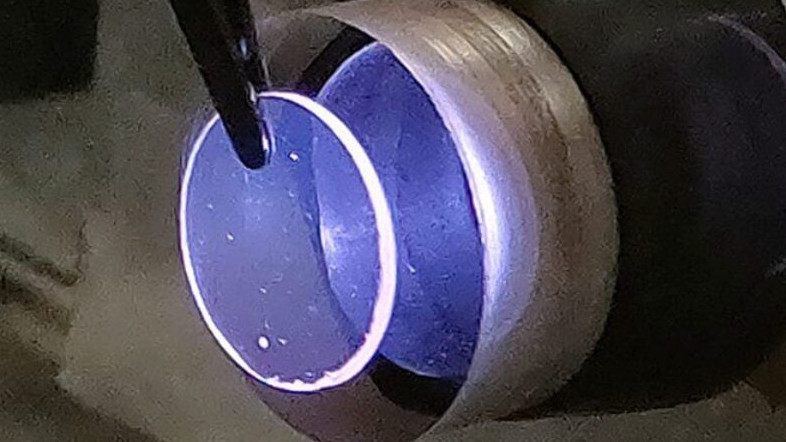New form of crystal storage stores terabytes of data per square millimeter
"Now you can pack terabytes of bits within a small cube of material that's only a millimeter in size"

Earlier this month, researchers from the University of Chicago's Pritzker School of Molecular Engineering demonstrated a technique that allows ones and zeroes to be made from atom-sized crystal defects, allowing for supreme density of "terabytes of bits within a small cube of material that's only a millimeter in size," per an interview with EENewsEurope.
This quote comes from UChicago PME Assistant Professor and lab overseer Tian Zhong, who also explained that "Within that millimeter cube [where we've made charged atom-defect gaps "one" and uncharged gaps "zero"], we demonstrated that there are about at least a billion of these memories— classical memories, traditional memories— based on atoms."
Explaining some finer details of how all of this works, postdoctoral researcher and first listed author of the original paper, Leonardo França, stated, "We found a way to integrate solid-state physics applied to radiation dosimetry with a research group that works strongly in quantum, although our work is not exactly quantum. There is a demand for people who are researching quantum systems, but at the same time, there is a demand for improving storage capacity of classical non-volatile memories. And it's on this interface between quantum and optical data storage where our work is grounded."
In other words, this work is derived from two key sources. Firstly, existing radiation dosimeters, which measure how much radiation people are exposed to in hospitals and particle accelerators. Secondly, existing research on quantum storage storing qubits instead of traditional bits already sees crystal defects used to make qubits. However, the methodology there doesn't tend to involve applying a charge to those defects.
We've also covered some other efforts at high-density storage on unconventional mediums before. Most relevant to this story is certainly the "5D memory crystals" touting the ability to achieve 360 terabytes in a 5-inch square...but considering the count of at least 2-3 terabytes within a 1 millimeter cube and the fact that 5 inches is about 127 of those...it would seem that these storage crystals are comparable if not even better than those. Unfortunately, no exact quote was provided on how many "terabytes" fit within a single millimeter cube.
Get Tom's Hardware's best news and in-depth reviews, straight to your inbox.

Christopher Harper has been a successful freelance tech writer specializing in PC hardware and gaming since 2015, and ghostwrote for various B2B clients in High School before that. Outside of work, Christopher is best known to friends and rivals as an active competitive player in various eSports (particularly fighting games and arena shooters) and a purveyor of music ranging from Jimi Hendrix to Killer Mike to the Sonic Adventure 2 soundtrack.
-
Zforgetaboutit Title should beReply
"New form of crystal storage stores terabytes of data per cubic millimeter." -
A Stoner Limit...Reply
'In 1 cubic mm of diamond, there are approximately 1.74 x 10^22 carbon atoms. '
17,400,000,000,000,000,000,000
17,400 billion billion
17,400 million trillion
There is quite the opportunity if each bit is stored in each individual atom. -
Zforgetaboutit According to the article, ideally, it's 1-bit per defect, so I think if each of "your counted atoms" had a defect, there wouldn't be any 3-D diamond crystalline structure in the first place.Reply
Could 100% of all the structurally defective atoms remain associated with other carbon atoms to form some kind of lattice? Maybe, but it wouldn't be diamond. -
gg83 I read something about crystal storage as a medium over 20 years ago. It was 2000, I was in Cisco certification class and we were talking about it. I hope this is viable.Reply -
dmitche31958 Finally, I have enough storage for my video collection as well as my future AI collections. Well, maybe not all of the AI garbage. LOLReply -
why_wolf Reply
Yeah they've been interested in crystal storage for decades. Partially because of Sci-Fi (so many shows use crystals) but also because crystals are very stable over the super long term.gg83 said:I read something about crystal storage as a medium over 20 years ago. It was 2000, I was in Cisco certification class and we were talking about it. I hope this is viable.
Far as I'm aware the giant limitation this whole time has been how incredibly slow the various methods have been to write and read data to a crystal. Fine for a laboratory experiment, unacceptable for real world use. -
Blastomonas Another fancy storage medium. I bet that we are still using HDD and SSD in 20 years time .Reply
Still waiting on my glass and DNA storage systems.. -
TheOtherOne Reply
Just like we STILL use Lithium batteries, or Petrol / Diesel for vehicles, or light bulbs with very short life span..Blastomonas said:Another fancy storage medium. I bet that we are still using HDD and SSD in 20 years time .
Still waiting on my glass and DNA storage systems..
It's all about consumerism and making money rather than advancing humanity to farthest possible way. -
usertests Reply
There are datacenters that will get what they want if it's viable. Worldwide demand for video storage is continuing to grow fast, and some fields like astronomy could use any amount of yottabytes they are given. But these glass/crystal technologies not only look slow to write to, but are probably write-once-read-many which will limit the applications. DNA storage could be even worse.TheOtherOne said:Just like we STILL use Lithium batteries, or Petrol / Diesel for vehicles, or light bulbs with very short life span..
It's all about consumerism and making money rather than advancing humanity to farthest possible way. -
Geef We 'all know' these are worthless...Reply
They aren't even made in the 1:4:9 dimensional ratio...
https://i.imgur.com/JShGMkK.jpg